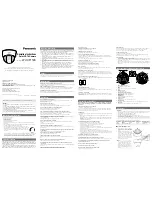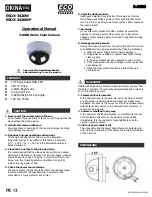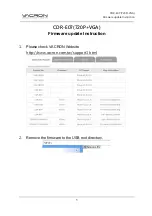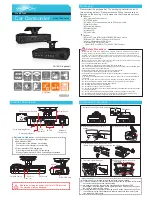
■
About the side cable access hole
If you choose not to drill hole in the ceil-
ing, but to wire the camera with the
cable exposed, cut the cable access
hole on the side of the dome cover to
provide a cable entry.
Note:
Cut out the part as show in the illus-
•
tration.
Precautions when wiring from the side:
Move the cable to one side as shown.
•
Be careful not to pinch the cable with
•
the dome cover.
Installing the camera directly on a ceiling
83.5 mm
15 mm
Recommended screw
(M4, 2 pcs.)
Cable mounting
hole in ceiling
Screws
(M4, locally procured)
LO
C
K
Front
Installation of camera
Turn off the power of all related devices before installation.
z
Remove the camera dome cover.
x
Connect all cables.
If necessary, bind the cable with cable tie (locally procured).
c
Install the camera.
Mount the camera with 2 screws (M4, locally procured).
Important:
Be sure to avoid twisting the cables when tightening the screws.
•
Note:
When attached to the ceiling:
•
Install the camera with its front (Model number indication face) facing the same direction
as the “
g
FRONT” arrow of the installation mark.
Installation
■
Pan and tilt adjustment
Important:
When adjusting pan or tilt, do not hold the lens of the camera.
•
q
Adjustment of panning position
Loosen the panning table lock screw and rotate the table to determine the
panning position (adjustable range: 350°).
The panning position can be adjusted b180° (clockwise) and –170° (counter-
•
clockwise).
After the panning position is determined, fix the panning table with the panning table lock
•
screw.
(Recommended torque: 0.59 N·m)
w
Adjustment of tilting position
Turn the tilting table to adjust the tilting position of the camera. (adjustable
range: +75 °)
After the tilting position is determined, fix the tilting table with the tilting lock screw.
•
Tighten the tilting lock screw after adjustment. (Recommended torque: 0.
•
59 N·m)
Note:
The
•
image top mark is facing
“ΔTOP” to display the image.
Adjustment
Counter-
clockwise: –170 º
Panning
table
Clockwise: +180 º
Original position mark
Panning table
lock screw [LOCK]
LO
CK
LO
CK
Adjustable range:
+75 º, 0 º
Image top mark
LO
CK
■
Connections
Connect the coaxial cable (locally procured)
Important:
Be sure to turn off the power of each device before connecting.
•
Be sure to secure the coaxial cable connectors.
•
Connect a coaxial cable to the video output connector.
Connect the power supply
Connect the two-color conductor cable of the camera to the power supply. The colors and
functions of the conductors are shown below.
Color
12 V DC
Red
Positive
Black
Negative
Important:
The power supply of 12 V DC shall be insulated against 220 to 240 V AC.
•
Power cord
(DC INLINE JACK PLUG
TYPE:
ø
5.5×2.1)
Video output
connector
LO
CK
LO
CK
Use a pen to mark the positions of the screws and cable mounting hole in the ceiling.
Attach the camera with 2 screws (M4, locally procured).
z
Align the mark with [ | ] on the dome cover, and then install the dome cover.
x
Adjust the orientation of the dome cover.
Turn the dome cover clockwise until the mark aligns with [ || ] and a click is heard.
Turn the dome cover to the left or right while viewing the monitor so that the light is not
blocked.
Important:
Be sure to align the mark with [
•
|| ] when adjusting the dome cover. Do not apply exces-
sive force, or you may cause damage.
c
Lift up the dome cover and then turn it clockwise until the mark aligns with [ ||| ]
and a click is heard.
v
After finishing the installation, completely peel off the protection sheet that had
been retained on the camera.
Attaching the dome cover
Mark
Mark [ | ]
Opening
(approx. 10 mm)
Mark [ || ]
Mark [ ||| ]
Before asking for repairs, confirm the causes with the following table.
Contact your dealer if a problem cannot be solved even after checking and trying the solution
in the table or a problem is not described below.
Symptom
Cause/solution
No image displayed
Are the power cord and coaxial cable connected
•
appropriately?
Check whether the connection is appropriately
→
established.
Is the adjustment monitor connected?
•
Confirm whether the monitor is connected.
→
Is the monitor brightness appropriately adjusted, or is
•
the contrast appropriately adjusted?
Check whether the monitor settings are
→
appro-
priate.
Is the cushioning material in the spherical cover
•
removed?
Confirm whether the cushioning material has
→
been removed.
Blurred image
Is the spherical cover dirty or damaged?
•
Verify the state of the spherical cover.
→
Is the focus adjusted correctly?
•
Check if the focus is adjusted correctly.
→
Is the lens of the camera soiled with dirt or dust?
•
Check whether the lens of the camera is clean.
→
Black line in image
Is the connected system controller set to multiplexed
•
vertical drive (VD2)?
Check whether the connected system controller
→
is set correctly.
Damaged power cord sheathing
The power cord or connector is damaged.
•
Continuous use of the damaged cord or connector
may cause electric shock or fire.
Turn off the power supply immediately and request
repair from your dealer.
Heated portion of power line con-
sisting of power cord and con-
nector during use
The temperature of power cord
rises or falls when the power cord
is bent or stretched during use
Troubleshooting
Power source
12 V DC
Power consumption
12 V DC: 120 mA
Image sensor
1/3-type interline transfer CCD
Effective pixels
976 (H)×582 (V)
Scanning area
4.8 mm (H)×3.6 mm (V)
Scanning system
2:1 interlace
Scanning line
625 lines
Horizontal scanning frequency
15.625 kHz
Vertical scanning frequency
50.00 Hz
Synchronization
Internal (INT)
Horizontal resolution
600 TV lines
Vertical resolution
400 TV lines
Video output
1.0 V [p-p] PAL composite video signal 75 Ω
Signal-to-noise ratio
52 dB (AGC OFF)
Minimum illumination
0.08 lx (color mode) at F1.4
0.07 lx (black-and-white mode) at F1.4
* corresponding value
Lens
Fixed Lens
Focal length
3.6 mm
Aperture ratio
F1.8
View angle
77 ° (H) × 57 ° (V)
Adjustable angle range
Pan: +180 ° to –170 °
Tilt: +75 ° to 0 °
Ambient operating temperature
–10 °C to +50 °C
Ambient operating humidity
Less than 90 %
Dimensions
ø108 mm × 88 mm (H)
Mass
200
g
Light control mode
ELC (Auto IRIS)
Auto black stretch (ABS)
ON
Auto gain control
ON
White balance
ATW
Digital noise reduction
ON
Day & Night (Electric)
AUTO
Values of weight and dimensions are approximate. The specification is subject to change
*
without notice.
Auto black stretch [ABS]
The latest digital signal technology is applied to automatically detect the dark areas in the
image, acquire the brightness data around the dark areas, and perform real-time color adjust-
ment by calculating the best correction curve for each area. This function can be used to per-
form real-time adjustment and correction of back light and dark area, and reproduce natural,
clear images.
Auto gain control [AGC]
Automatically increases the gain to make the screen brighter when the illuminance of the sub-
ject becomes darker.
Auto tracking white balance [ATW]
Activates the automatic color temperature tracking mode.
The camera continuously check the color temperature of the light source and automatically
adjusts the white balance. The adjustment of the color temperature ranges from approx. 2700
K to 6000 K.
Digital noise reduction [DNR]
The digital noise reduction function reduces noise automatically under the condition of low illu-
minance.
Day & Night (Electric) [D&N (ELE)]
Automatically switches between color and black-and-white images in accordance with the illu-
minance.
Switches to black-and-white images when the illuminance around the camera is lower than
approx. 0.07 lx at F1.4 *corresponding value
To obtain color images, a sufficient level of illuminance (approx. 3.0 lx at F1.4 *corresponding
value) is required.
The switching illuminances described above are reference values. The switching illuminance
shall be decided based on the actual installation environment.
There may be repeated switching between color and black-and-white images depending on
the setting and environment.
Specifications
Operating Instructions (this document) ......... 1 pc.
Standard accessories
Connection of power cord
When connecting the power cord, use connectors that are designed for the power cord, and
be careful not to let the power cord fall off.
In addition, waterproofing work is needed at the joint, e.g., wrapping waterproof tape around
the joint.
Cable length and wire gauge
12 V DC
Calculation of the relation among the cable length, resistance, and power supply.
The voltage supplied to the camera shall be between 10.8 V DC and 16 V DC.
10.8 V DC ≤ V
A
- 2 (R x I x L) ≤ 16 V DC
L : Cable length (m)
R : Resistance of copper wire (Ω/m)
V
A
: DC output voltage of power supply unit
I : DC current consumption (A)
See specifications.
Resistance of copper wire [at 20 °C]
Copper wire size
(AWG)
#24
(0.205 mm
2
)
#22
(0.325 mm
2
)
#20
(0.519 mm
2
)
#18
(0.833 mm
2
)
#16
(1.307 mm
2
)
Resistance Ω/m
0.083
0.052
0.033
0.020
0.013
Side cable access hole




















